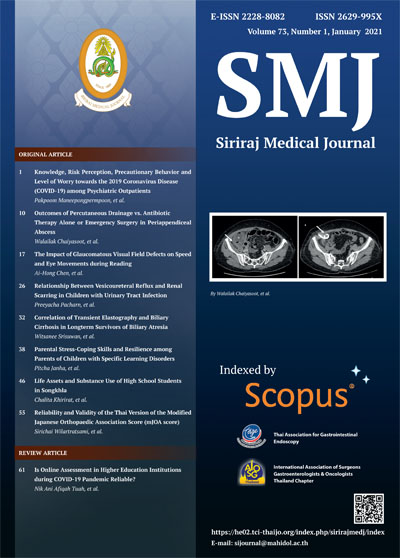Life Assets and Substance Use of High School Students in Songkhla
DOI:
https://doi.org/10.33192/Smj.2021.07Keywords:
life assets, substance, student, high schoolAbstract
Objective: To examine the association between life assets (including demographic factors) and substance use among high school students.
Methods: In this cross-sectional study, 1,713 participating students were asked to fill out questionnaires. Data were analyzed using descriptive statistics (e.g., mean, frequency and standard deviation); associating factors were analyzed via univariate analysis and ordinal logistic regression.
Results: Among the participants, 67.5% were females with a mean age of 16.4±0.96 years. On average, the participants have a good level of overall life assets, except for community power. Those with a mean age of 14.3 years engaged in substance use early, with peer influence being a leading cause (8.1%). 48.0% of the participants had used substance in their lifetime, and 74.7% of them had used only 1 substance, with alcohol being the most prevalent (97.7%). An excellent level of participant life assets, especially wisdom power, was negatively associated with substance use (OOR = 0.48). Other significant factors that discouraged substance use were being an only child (OOR = 0.75), having a high cumulative grade point average (GPA) (OOR = 0.63), and belonging to a two-parent family. (OOR = 0.79)
Conclusion: This study affirms a negative relationship between an excellent level of life assets, especially wisdom power, and substance use. Demographic factors like being an only child, having a high GPA, and belonging to two-parent households also showed a strong negative association with substance use.
References
2. Kanato M, Assanangkornchai S, Charoenratana S. National household survey, estimation of population related with substance abuse. Bangkok: Jaransanitvong Press, 2016.
3. Ruangkanchanasetr S, Plitponkarnpim A, Hetrakul P, Kongsakon R. Youth risk behavior survey: Bangkok, Thailand. J Adolesc Health 2005;36(3):227-35.
4. Choosunthia W, Pinitsuntorn S. The impact of drug addiction on patients admitted to Thanyarakhospital, Udonthani: a case study. CHDKKU 2017;5(3):523-33.
5. Tripathi S, Musikaphan W. Quality of children’s life 2013. 1st ed. Bangkok: Appa printing group, 2013.
6. Kodjo CM, Klein JD. Prevention and risk of adolescent substance abuse: the role of adolescents, families, and communities. Pediatr Clin North Am 2002;49(2):257-68.
7. Beebe L, Vesely S, Oman R, Tolma E, Aspy C, Rodine S. Protective assets for non-use of alcohol, tobacco and other drugs among urban American Indian youth in Oklahoma. Matern Child Health J 2008;12:82-90.
8. Oman R, Vesely S, Aspy C, McLeroy K, Rodine S, Marshall L. The potential protective effect of youth assets on adolescent alcohol and drug use. Am J Public Health 2004;94(8):1425-30.
9. Hussong A. Differentiating peer contexts and risk for adolescent substance use. J Youth Adolescence 2002;31(3):207-20.
10. PL Benson, EC Roehlkepartain. Tapping the power of community: building assets to strengthen substance abuse prevention. Search Institute Insights & Evidence 2004;2(1):1-14.
11. Murphey D, Lamonda K, Carney J, Duncan P. Relationships of a brief measure of youth assets to health-promoting and risk behaviors. J Adolesc Health 2004;34(3):184-91.
12. Tripathi S, Sungthong P, Salachan S. User Guide on Life Assets Inventory for Thai Children and Youth (youth version). 2nd ed. Bangkok: Appa printing group, 2010.
13. Srichantr-intr N, Ketumarn P, Tripathi S. Life assets in academically talented students: case study of the participants in international mathematics and science Olympiad 2013. J Psychiatr Assoc Thailand 2014;59(2):151-62.
14. Tripathi S. The national survey of life assets (positive youth development) among secondary school students in Thailand. J Adolesc Health 2013;52(2):s6.
15. Petchruschatachart U, Balthip K, Piriyakoontorn S. Life’s assets and quality of life of Thai junior high school adolescent, Songkhla province. Songklanagarind J Nurs 2016;36(4),55-69.
16. Office of the Narcotics Control Board: Ministry of Justice. Report of Illicit drug situation in 7 provinces of southern Thailand. Bangkok: Ministry of Justice, 2017.
17. Assanangkornchai S, Tantirungsi N. ASSIST, ASSIST-Lite, ASSIST-Y and e-ASSIST. 1st ed. Songkhla: Prince of Songkla University, 2014.
18. Mukangi A. The role of birth order in substance related disorders. AJOL 2010;2(2):221-37.
19. Hemovich V, Lac A, Crano WD. Understanding early-onset drug and alcohol outcomes among youth: The role of family structure, social factors, and interpersonal perceptions of use. Psychol Health Med 2011;16(3):249-67.
20. Hawkins J, Catalano R, Miller J. Risk and protective factors for alcohol and other drug problems in adolescence and early adulthood: implications for substance abuse prevention. Psychol Bull 1992;112(1):64-105.
21. Chinakate S. Factors affection to preventive behavior on drug among the vocational certificate students in college under the provincial vocational education of Ratchaburi [Thesis]. Nakhon Pathom: Silpakorn University; 2010.
22. Schulenberg J, Bachman JG, O'Malley PM, Johnston LD. High school educational success and subsequent substance use: a panel analysis following adolescents into young adulthood. J Health Soc Behav 1994;35(1):45-62.
23. Chagphimai C, Sritanasal P. Self-defense behaviors from drugs of students at king Mongkut’s university of technology north Bangkok [Thesis]. Bangkok: King Mongkut’s University of Technology North Bangkok; 2001.
24. Srisatchang A. Knowledge, understanding, and factors related to students’ drug abuse at Prince of Songkla University [Thesis]. Songkhla: Prince of Songkla University; 2002.
25. Whitesell M, Bachand A, Peel J, Brown M. Familial, social, and individual factors contributing to risk for adolescent substance use. J Addict 2013;2013:1-9.
26. Bandura A. Influence of models' reinforcement contingencies on the acquisition of imitative responses. J Pers Soc Psychol 1965;1:589-95.
Published
How to Cite
Issue
Section
License
Copyright (c) 2020 Siriraj Medical Journal

This work is licensed under a Creative Commons Attribution-NonCommercial-NoDerivatives 4.0 International License.
Authors who publish with this journal agree to the following conditions:
Copyright Transfer
In submitting a manuscript, the authors acknowledge that the work will become the copyrighted property of Siriraj Medical Journal upon publication.
License
Articles are licensed under a Creative Commons Attribution-NonCommercial-NoDerivatives 4.0 International License (CC BY-NC-ND 4.0). This license allows for the sharing of the work for non-commercial purposes with proper attribution to the authors and the journal. However, it does not permit modifications or the creation of derivative works.
Sharing and Access
Authors are encouraged to share their article on their personal or institutional websites and through other non-commercial platforms. Doing so can increase readership and citations.















